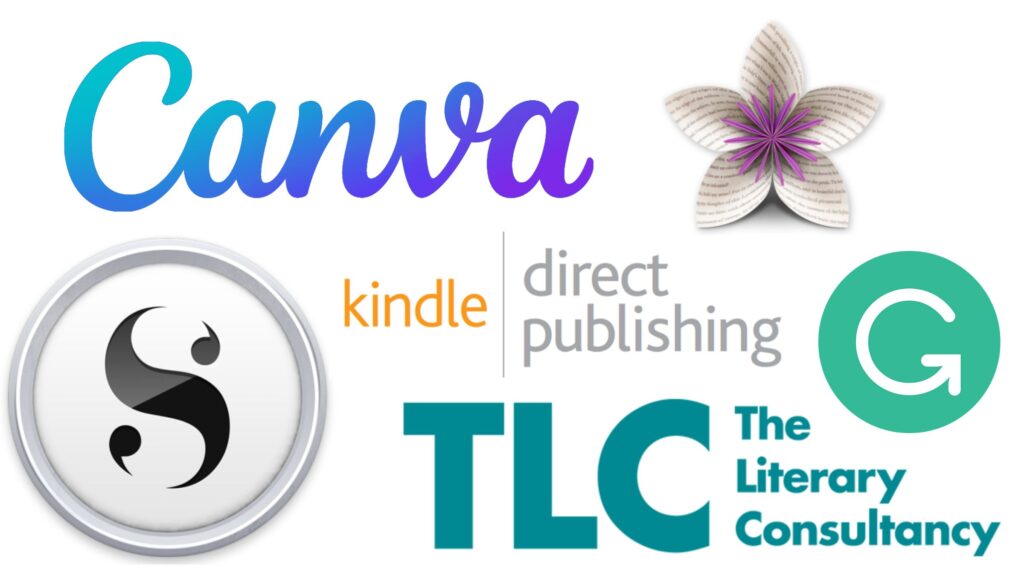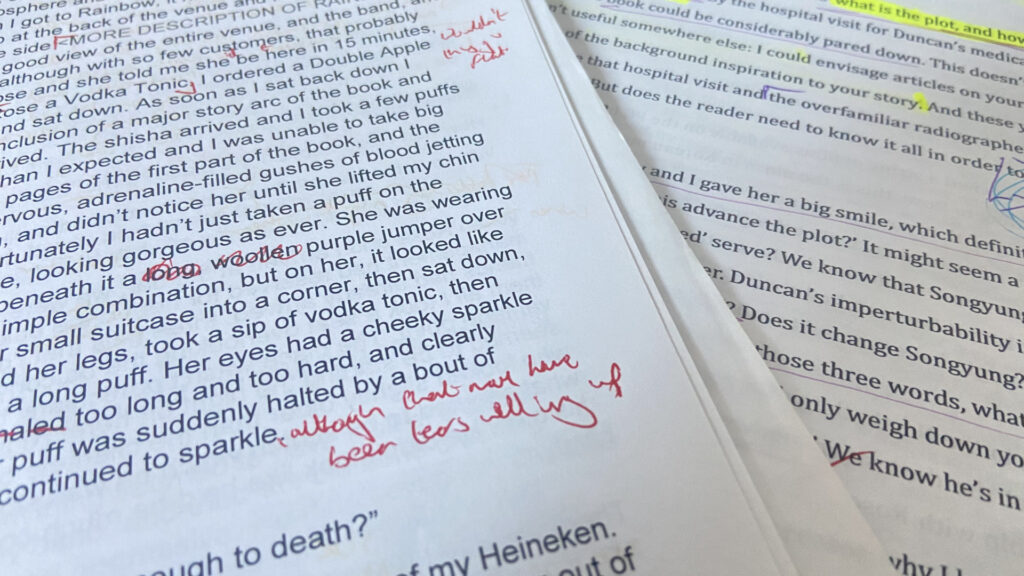It took roughly nine years to finish the first draft of my first novel. Not that it was nine years of dedicated work. There were gaps of months, even years between periods of dedicated, engrossed writing, interspersed with short stories and primarily, my career. An initial lack of a proper plan or a fully envisaged story arc did not help and was still apparent after two drafts. Draft 1 of the novel lacked even a title. Instead, the project retained the name of Jenny, a once major character I decided to completely omit in 2013. It wasn’t until 2020 that I gave the novel its title: Eight Seasons.
Draft 1: Pleasure
Fortunately, in 2013, I created an organisational system that allowed me to pick it up each summer, knowing where I left off and what needed doing next. I also did some initial editing: tidying everything up, removing some of the chunks and omitting Jenny herself, a step which changed the trajectory of the whole story. After this major reorganisation, I barely touched the manuscript until 2015, when I visited Korea, where the book is set. I visited Korea twice again the following year and whilst there, added new sections, often requiring quite extensive research into topics I knew little about. The following year was another fallow year as I moved to a new job, ruptured my Achilles tendon and then got married in the Summer. It wasn’t until 2018 that I started to make significant progress, sewing together the ‘chunks’ with a fully-planned story arc, a timeline of real-world events and a fleshed-out character bank.
Finally, I was able to stitch season by season together relatively seamlessly and on September 1st 2019, the first draft was complete. The pride and relief were both fleeting, especially with the realisation that at approximately 161,000 words, no publisher would ever take it seriously. Even the most supportive of literary-minded friends would find it a drag. So, after printing a paper manuscript, I spent the next nine months red-penning each season, scrawling notes on consistency checks, typos and whole passages to consider cutting down, re-writing or ditching entirely. By the end of that process, I had already realised more drastic measures still were necessary.
Draft 2: Pain
Ruthlessness was required, but I’d also need to improve my process. Beyond anything else, I needed dedicated time to finish the story, so I decided to leave my steady teaching job and work supply for some time. I also began telling people that I was quitting to finish a novel, hoping that self-inflicted pressure would spur me on.
Before commencing the second draft in earnest, I researched what tools and processes more experienced authors and editors used. The most significant change was switching from my carefully organised but cumbersome system of Word documents to Scrivener, hoping to keep everything easily accessible and organised, all in one window. I’d read effusive praise for the program and it certainly proved a step up from Word, meaning I could find everything faster and got less distracted flitting between documents and folders.
The second draft was brutal. Whilst Covid raged and mutated, I was sat at my laptop, hacking sections out of my first draft. In July 2020 alone, 16,500 words were cut, 15,000 more in August and 18,000 in September. Three significant secondary characters were ejected. Flabby sections, trite analogies and passages of over-explanation were trimmed or filed elsewhere. On September 22nd 2020, I finished the second draft, with just under 111,000 words. Still not quite at my target of 110,000 but I knew I could make it.
Draft 3: Critiqued
The following week saw a reality check when for the first time in years, I didn’t receive a monthly paycheck. Direct debits disappeared money from my account and soon after, I accepted a full-time temporary supply teaching role, starting mid-October. Before starting, having taken a two-week break from the manuscript, I further researched self-editing, prompting several realisations.
Primarily, and frustratingly, I realised that the second draft still had one major structural flaw; the protagonist’s love interest needed to be introduced much earlier. Thus, Draft 3 commenced with some significant section movements and re-writing, subsequently requiring re-editing from the beginning. Once I’d overcome this hurdle, however, it was relatively simple and I was able to edit several chapters a week whilst working full-time.
Finally, on January 7th 2021, just as I started a new permanent teaching role, the third draft was completed, totalling approximately 109,900 words. Relief was there again, that sense of accomplishment too, but also a sense of ‘now what?’ Over the next few weeks, I did some half-hearted spellchecking and formatting, the odd bit of research about self-publishing and then finally knew it was time to act. After one final spell-check using Scrivener (later realising this isn’t one of the program’s strengths), I sent it out to four beta readers in February. Like me, two had worked in South Korea, where the book is set, and the other two were two of my best friends.
The initial feedback on the first few chapters was positive: the story was well-written, there were funny sections and the description of arriving in Korea was accurate. But then the reactions dried up. Somewhere along the line, three of my beta readers must have gotten bored and did not finish the story. Around the same time I sent out the beta copies, I had also sent some early chapters to various agents. Unsurprisingly, I received nothing more than rejections. If my friends lost interest, there was probably little for an agent to work with.
However, all was not lost. One beta reader persisted, taking a while to read the first half, then finished the second half at pace. Not only had she read it, but it had stirred her emotionally and she had engaged with the characters, both positively and negatively. I already suspected that the best chapters were in the latter half, but I had not anticipated readers not even reaching it. It was apparent that another draft was needed, but I found myself unsure of what to do next. Clearly, it needed a lot of work, but by this time I had already so wrapped up in the project, having invested so much time and effort, that I felt blind to the main problems, let alone how to solve them. The other beta readers had been too polite or otherwise unwilling to say outright why they had stopped reading, but their silence spoke volumes. I needed help from a professional.
At somewhat of a loss, I tried to speak to people who I knew had been published. Unfortunately, those I knew had all published non-fiction, so their experience and suggestions were not entirely relevant. I then found out that a friend-of-a-friend whom I had once met at university, Sophie Haydock, was about to publish her debut novel, The Flames. I messaged her asking for advice, and she sent me in the direction of The Literary Consultancy. I will write a subsequent post about them later, but the feedback I received from them was exactly what was needed. The three main takeaways were:
1) The protagonist’s meeting with his love interest needed to be moved even further forward.
2) The protagonist needed more backstory.
3) The book essentially had two non-complementary components. Firstly, the story itself and secondly, a travelogue. The latter was distracting from the former. I was advised to trim back whole sections which read more like travel writing. They suggested I cut down the word count from 110,000 to 80 or 90,000.
Draft 4: Response
This third piece of feedback was a revelation. The moment I read it, I could see that was precisely what was wrong with the story. However, I knew that reducing it down as far as suggested would be a huge challenge. Using The Literary Consultancy’s report as guidance, I completed a fourth draft faster than expected, although it still came in at 100,000 words. Had I not done step 2 of the above feedback, it would have been closer to 90,000, but I was pleased with the protagonist’s new backstory, feeling it gave him more depth and interest for any future readers. I also improved the pacing, ensuring that each chapter’s end left the reader wanting to continue to the next.
Draft 5: Completion
Draft 5 took a bit longer. By this stage, a certain fatigue had set in and I just wanted to get it released so I could move on to another project. Not wishing to spend more time and effort hawking my book to agents, I’d decided upon self-publishing. Even had it been picked up by an agent, there was no guarantee of a publishing deal. Should it have then been selected by a publisher, it would have likely required further re-writing and editing, which itself did not guarantee sales. Seeing the success of authors such as R.R. Haywood and Christopher Shevlin and having enjoyed their books, I felt I could self-publish a final manuscript that I would be happy with. Still, I wanted it to be as polished as possible without spending a small fortune. I had decided not to pay for line editing despite the importance placed on it by the majority of articles I’d read.
Instead, I gambled upon my grasp of spelling, punctuation and grammar. Well, my own and that of a well-advertised writing assistant program. Somewhat painstakingly, I put each of the forty chapters through the free version of Grammarly. This undoubtedly saved me money, at the cost of my time. Once finally done, I read through the manuscript, making a few more edits for readability or where Grammarly hadn’t picked something up.
In the Summer of 2023, I then sent it out to an old friend who like me, worked in education, so had a summer holiday and plenty of free time. Though well-read, since Covid, like many of us, she had found it hard to concentrate and had read less in recent years. She’d previously read a few of my short stories before but hadn’t finished all of them. Additionally, she was forthright and honest, so I felt she’d be a worthwhile beta reader for Eight Seasons.
She finished it in under a week. Not only that, her feedback was extremely positive and helpfully identified several more typos for me to correct. I subsequently sent it on to two more beta readers, one of whom was in my initial group of beta readers. Although she had less time to read herself, she finished it this time and seemed to enjoy it. The third person was a childhood friend who previously worked in the publishing industry and gave me some good final pieces of feedback. Finally, it was ready.
However, a final hurdle emerged. Around this time, I found out that the Australian visa we’d applied for (possibly another pending post) had come through, much quicker than anticipated. Suddenly, our to-do list sprawled and publishing Eight Seasons got shunted down the order. Despite that, I made time when I could.
Formatting
While waiting for the final two beta readers to finish, I had started on the cover art, using the free Pro trial of Canva and the more discerning eye of my partner. I also formatted the manuscript on Vellum, again on trial mode, before waiting to pay for it on Cyber Monday (30% discount) in November. Finding myself free one evening later that week, and having finalised the cover, I realised the book was primed to publish. My partner too was more than ready for me to release it, sick of the delays and hearing my latest updates about the same bloody story. Having read that any books published in December get lost amidst Christmas stories and traditionally published bestsellers, I decided to publish Eight Seasons on January 1st 2024.
Publishing
I signed up to KDP (much easier than I thought), choosing categories and keywords with some help from Publisher Rocket, finalised the pre-publication and ordered myself a few proof copies of the paperback. I signed up for both Booksprout and BookSirens, hoping to get some reviews on advanced reader copies, but with little uptake. Still, the proof copies looked good and I believed in my story.
On New Year’s Day, my debut novel was finally released. Though the sales have been slightly slow, several people have already finished the story and initial feedback has been overwhelmingly positive. Now all I need to do is work out how to market it.
As for my next projects, I will shortly be releasing Fifty Mosquitoes, a novella also set in Korea, one year after the events of Eight Seasons and tying in with its final chapter. It is not a sequel as such and both stories can stand alone, but I have always hoped to create a literary world connecting the characters of my stories to other stories, and this is the beginning of that. I have also got a set of short stories and novellas, again with number-themed titles to be released and hope to edit and self-publish 1-7 as a collection sometime in the next eighteen months. Other than that, I am also outlining my next novel, likely to be the first in a series. The working title for that is the Author for Hire. Oh, and we are moving to Australia this weekend. 2024 will be a busy year and I intend to update this website with my progress. Sporadically.



